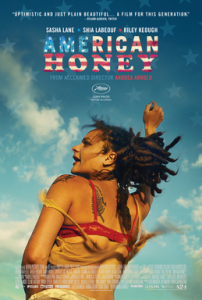reconfiguring the female victim in american honey

With university holidays upon me, the luxury of leisure time unfurled, lovely and inviting. Finally, time to catch up on all the music, books and films that had been stockpiling. A little behind the eight ball, I immersed myself in Andrea Arnold’s epic 163-minute Cannes Jury Prize winner American Honey. I had heard little about the movie other than its notable length and use of untrained actors, and I was intrigued to see how Arnold tackled the portrayal of women in her first film set in the American landscape. Given the blow to the female psyche after the recent US presidential election, it felt like a cathartic and necessary exploration, and maybe a window into an ugly world.
Equal parts coming of age road story and love letter to forgotten landscapes, American Honey was inspired by a 2007 New York Times article about ‘mag-crews’. The film follows a group of downtrodden young adults making their way across the country selling magazines door to door. Its mastery comes not through the basic plot but through visual splendor and insightful yet undogmatic exploration of themes. Refracted light is cast across diverse landscapes, class divides, capitalist idealism and, most interestingly, expectations of gender. The result: a refreshing take on feminine representation that will likely divide, due to Arnold’s refusal to assign judgment. Instead, responsibility is placed on the viewer, forcing the gaze to turn inwards on our own existing preconceptions about women, the situations they face, and how they behave in them.
The film’s central character is 18-year-old Star (Sasha Lane), a poster child of a damsel in distress. Early on we see her in her home: a drunken father figure grabs at her arse, a slippery tongue enters her ear, and she sobs into an ambivalent shirtsleeve. At this point we could easily and graphically embark on a tale of the dangers and horrors faced by young women, but what we get is something quite different. Star plots her escape and joins the mag crew on the road after locking eyes with the unexpectedly charming Jake (Shia LeBeouf) in Wal-mart. But this is not a typical love story where a girl follows after a boy; she challenges him at every opportunity and refuses to compromise her values.
When Star starts work selling magazines, we are often on seats edge as she finds herself alone with men making her sales pitch. In one scene a group of middle-aged businessmen invite her inside (will she be sexually assaulted?), lead her down some stairs (locked in a basement?), out to a BBQ area with a bottle of tequila (are they getting her drunk to then assault her and lock her in a basement?). Until, ultimately they lay down money and buy her magazines. In another she gets into a truck, and we wait for the proposition that never comes. In these moments, we are forced to recognise that we are conditioned to always expect the worst things to happen to women, and this realisation is just as powerful as watching horrible acts unfold. Further, as an attractive young woman, had something have happened, how many viewers would watch on thinking “she should have known better.” Arnold handles the subject of sexual objectification, consent, and domination deftly, never dictating, but also never shying away from discomfort.
Through Jake, the role of the male hero is challenged. He is always ready to save his damsel, but we are left wondering whether she needs saving at all. When Star is made a $500 sexual proposition, she drives the bargain to $1000, and we are reminded that ultimately this is a film about getting out. Wealth is the one thing that can make these women equal to men. As the man strokes himself in the driver’s seat with his hand up her skirt, she stares off into the distance and sees the American dream play out. When Jake accuses her of sleeping with the man, she doesn’t concede, and she doesn’t say sorry. Unapologetically, she retains ownership over her decisions and the woman she is becoming.
The idea of the self-made woman is further explored through the Southern belle crew boss, Crystal. Another compelling female character, she rakes in money, beds young men, and gets rubbed down with fake tan in a confederate bikini. Arnold has said she considered casting Crystal as a man, but found this characterisation far more interesting: the woman who rises to the top and the kind of person she becomes in the process.
The film meanders to a close and we see the crew continuing to do what they have done for the last 2.5 hours: party hard, drink hard, and forget. Jake offers Star a turtle as a peace offering to their latest fallout, and she quietly goes to the waters edge to set it free, perhaps in the process freeing herself from his hold. Knowing that she can’t swim, as she walks out into the water, we are reminded of women drowning in their sorrows. Shakespeare’s Ophelia, Esther in Sylvia Plath’s The Bell Jar, and more recently the unnamed narrator in Eimear McBride’s A Girl is a Half Formed Thing. Star plunges her head under water and pauses just long enough for us to remember what we know about women and their struggles, what we expect. Then, as the final bubbles start to pop, she emerges from the depths, not gasping for air but radiant and controlled. A woman of tomorrow, ready to face another day and what it holds.
As American Honey rolls its credits I don’t delude myself into thinking that this is a world where nothing bad happens to women at the hands of men, or where women can always control what happens to them – but I am reminded of resilience, strength and tenacity. Something we can all hold onto as we embark on this new year and the battles we face, looking towards our own ideals of equality.

